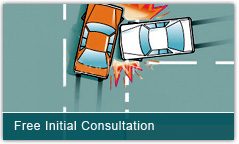Simulations and Animations
It has been said that a picture is worth a thousand words. If this is so, imagine what 30 linked pictures per second running at real time are worth!
At FDi, animations begin with a rigorous analysis of the event in question. This is usually performed by using specialized software such as PC-Crash, which provides the exact time/position history required by the animation software. By accurately determining where, when and how each object in the animation arrives at a certain place and time, the animating software can assemble the above information into a seamless "movie" that provides the intended audience with a very real, life-like experience.
PC-Crash has 'built-in' animating capabilities; however, for a truly dramatic visualization, we prefer to use specialized animation software such as 3D Studio Max and ARAS. This is the same type of software used by Hollywood studios for realistic visual effects. As this software has evolved, it has become very applicable to the accident reconstruction industry, and combined with the data input from other technical software, provides for the creation of realistic and technically accurate engineering animations.
To add to the realism, we often use an air photo as a backdrop. Three dimensional objects are then placed on the air photo for an even greater visual experience. For example, buildings can be constructed over top of the aerial 'footprint' and modeled with precision as compared to ground level photographs taken at the time of the accident, or shortly afterward. Also, various objects such as trees, shrubs and other forms of natural vegetation can be modelled in the scene, which will affect visibility issues. High level animations include suspension effects, skid marks being deposited when the brakes were applied, light effects, and even vehicle crush and debris occurring at the instant of collision. Our experience includes weather effects as well, such as animations depicting night time conditions, fog, snow, and even rain.
Modeling specialized vehicles such as articulated trucks towing a number of trailers is now possible, as present day software 'understands' the pivot point of these types of units. Sound tracks, recorded and played back with decibel level devices, can be incorporated into the animation for the ultimate real life experience. It is also possible to transition from an actual video, taken at the scene, to an animation, for additional effect.
Animations can often be completed in a matter of days, but the complexity of the event will determine how long an animator will require to complete the visualization. For example, incidents where numerous participants/vehicles must move about the scene will take more time to animate than a simple single person/vehicle event. Similarly, whereas it is relatively straight forward to provide viewpoints from several cameras located in the "scene", the greater number of clips the longer it will take the animator to render the event.
The flexibility in illustrating viewpoints is one of the key advantages to engineering animations. For example, a camera can be attached to the driver's seated position inside the vehicle for a constant changing view of what the driver was able to see and when as the vehicle moves about. Similarly, the witness positions can be the location of a camera so that the events, as they unfold, can be observed in real time from their location.
Another particularly useful feature of engineering animations is the ability to assess "what if" scenarios. For example, if a participant is found to be exceeding the speed limit, an analysis can be undertaken to investigate how the incident would have unfolded in a different fashion had the participant been travelling at the speed limit.
Not all circumstances are amenable to an engineering animation. For example, simple situations (particularly those that involve a single participant) which can be examined and discussed using words and perhaps diagrams alone, may not benefit with the use of an animation. However, those events which involve two participants in motion at the same time often become difficult to express in a written report format. Situations such as this lend themselves ideally to the production of an animation which visually describes, with pinpoint accuracy, where everyone is in the scene as they approach the collision.
In the past 25 years, FDi has produced hundreds of engineering animations and have had these accepted in Court, both in the United States and in Canada. In one particular case, the Honorable Justice Holmes had the opportunity to admit and view an FDi animation. In his written judgment, he noted the following:
![]() I found the video representations (animations) useful in visualizing the evidence.
I found the video representations (animations) useful in visualizing the evidence.![]()
Engineering animations can be used to examine a host of situations apart from those involving traffic accidents. For example, product failures, medical descriptions, or any other complicated area can be examined by performing an engineering animation that can help illustrate your case to the "other side" or a judge and/or jury.
For more animations and engineering videos, check out our new youtube page.





